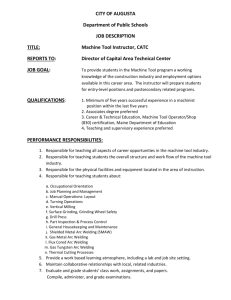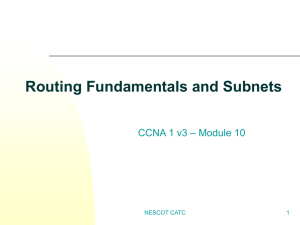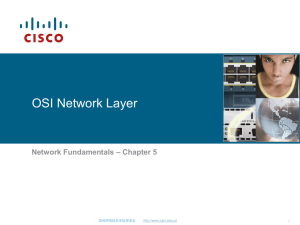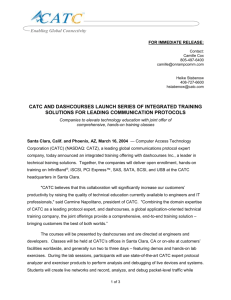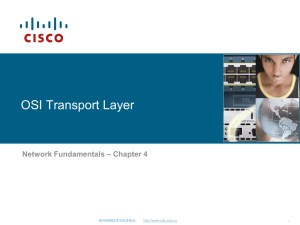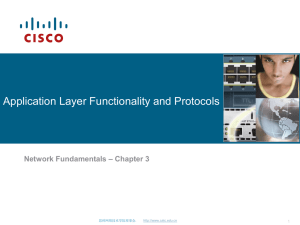Networking Fundamentals – Module 2 CCNA 1 v3 29/05/2016
advertisement
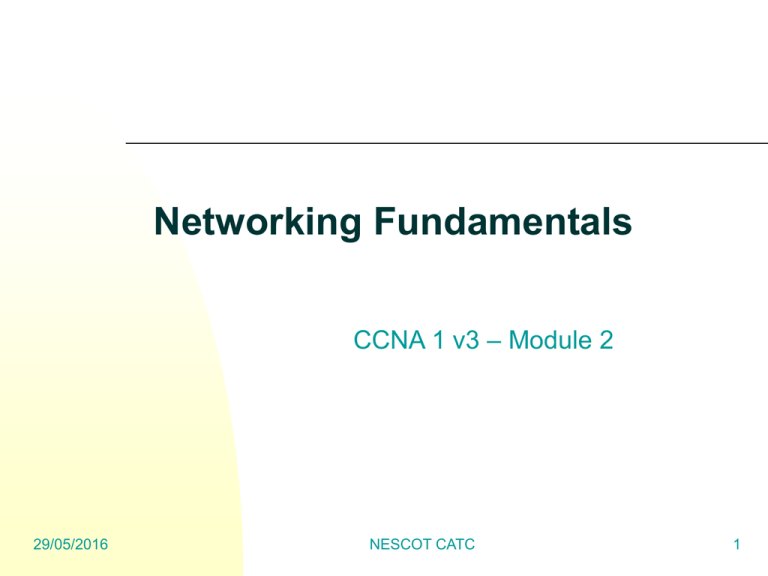
Networking Fundamentals CCNA 1 v3 – Module 2 29/05/2016 NESCOT CATC 1 Networking Terminology End-user devices provide users with a connection to the network. Also referred to as hosts. Allow users to share, create, and obtain information. Network devices provide transport for data between enduser devices. Provide cable connections, extensions, concentration. Conversion of data formats, and management of data transfers NESCOT CATC 2 Physical Topologies Physical topology is the actual layout of the wire or media NESCOT CATC 3 Logical Topology Logical topology defines how media is accessed by hosts 1. Broadcast means that each host sends its data to all other hosts on the network medium. Non-deterministic - there is no order that the stations must follow to use the network. First come, first served. Example: Ethernet 2. Token Passing controls network access by passing an electronic token sequentially to each host. When a host receives the token, that host can send data on the network. If the host has no data to send, it passes the token to the next host and the process repeats itself. Examples: Token Ring, FDDI NESCOT CATC 4 NESCOT CATC 5 LAN Operate within limited geographical area Allow multi-access to high bandwidth media Control network privately under local administration Provide full-time connectivity to local services Connect physically adjacent devices MAN Spans a metropolitan area such as a city or suburban area Usually consists of LANs in a common geographic area Example: a bank with multiple branches may utilize a MAN WAN Operate over a large geographical area Allow access over serial interfaces operating at lower speeds Provide full-time and part-time connectivity Connect devices separated over wide areas SAN High-performance network to move data to/from storage areas Separate, dedicated network avoids traffic conflict VPN Private network constructed within public network such as Internet Access VPNs, Intranet VPNs, Extranet VPNs NESCOT CATC 6 Bandwidth Bandwidth is limited by physics and technology Bandwidth is not free Bandwidth requirements are growing at a rapid rate Bandwidth is critical to network performance NESCOT CATC 7 Throughput Throughput refers to actual measured bandwidth, at a specific time of day, using specific Internet routes, and while a specific set of data is transmitted on the network. Often far less than the maximum possible digital bandwidth. Factors that determine throughput: Internetworking devices Type of data being transferred Network topology Number of users on the network User computer Server computer Power conditions NESCOT CATC T = Time S = Size BW = Bandwidth P = Throughput 8 Networking Models The historical and technical standard of the Internet is the TCP/IP model The U.S. Department of Defence created the TCP/IP reference model, to design a network that could survive any conditions, including a nuclear war Application layer handles issues of representation, encoding, and dialog control. Transport layer deals with the quality of service issues of reliability, flow control, and error correction Internet layer is to divide TCP segments into packets and send them from any network. Best path determination and packet switching occur at this layer Network Access layer (aka host-to-network layer) concerned with all components, both physical and logical, that are required to make a physical link NESCOT CATC 9 OSI Model • Reduces complexity • Standardizes interfaces • Facilitates modular engineering • Ensures interoperable technology • Accelerates evolution • Simplifies teaching and learning The OSI reference model was released in 1984 to help network builders implement networks that could communicate (interoperability) The OSI reference model is the primary model for network communications The process of moving information between computers is divided into seven smaller and more manageable steps NESCOT CATC 10 Presentation Session Transport Network Data-Link Physical DATA SEGMENT PACKET FRAME BITS 0101010101010101010 NESCOT CATC DECAPSULATION Application Destination ENCAPSULATION Source Application Presentation Session Transport Network Data-Link Physical 11 OSI Top 3 Layers – Application issues Application provides network services to the user's applications file, print, message, database and application services HTTP, SMTP, FTP Presentation responsible for manipulating data’s appearance as needed by the Application layer Data encryption, compression and translation services JPEG, MIDI, QuickTime, EBCDIC to ASCII Session establish and maintain communication between two hosts Dialogue control NFS, SQL, RPC, X Window NESCOT CATC 12 OSI Lower 4 Layers – Data Transport issues Transport PDU – Segment the transport layer establishes, maintains, and tears down virtual circuits Windowing TCP and UDP Network PDU - Packet Routing Data packets and route update packets connectivity and path selection between two hosts Data-Link PDU - Frame physical addressing, network topology, network access, error notification, ordered delivery of frames, and flow control Ethernet LCC and MAC layers Physical PDU – bits NESCOT CATC 13 Cabling, standards
